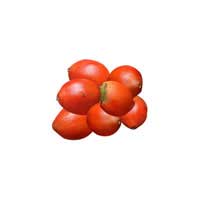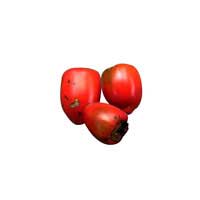 Full List of Fruits
Full List of Fruits  Peach palm
Peach palmPeach palm Fruit
Scientific name - Bactris gasipaes
Bactris gasipes come under the family of sea island palms .like most other palms they grow erect and are restricted to warm climatic conditions. These kinds of trees generally consist of a single slender stem or several stems not more than a number of 8 .The thickness of these trees are 20 cm. They grow together as a cluster. They are enclosed with stiff, black spines all over their trunk from the base to the top of the tree. There is an exception in which sometimes there is lesser number of spines. The average length of the tree is measured to be 20 meters which is 66 feet but it can be taller too. Their leaves are pinnate which are similar to a feather with a frond of a fern. Coming to the fruit it comes under the classification of drupe which has a outer fleshy part which surrounds a seed with it, it has a length of 4-6 cm and a breadth of 3-5 centi -meters.the peel of the fruit may be of red, yellow or orange color after it ripenes ,these colors also depends on the type of palm family it belongs to.
![]() Nutritional Value of Peach palm
Nutritional Value of Peach palm
The fruit is very nutritious containing an amount of 196 calories which is divided by the H2O, protein, fat content ,the carbohydrate , fiber content and a very less amount of ash which is just 0.8 gram, content since it grows under tropical climatic conditions. The energy content in the fruit is very high topping to be 196 kilo calories or 816 kilo joules, this proves the fruit to be highly nutritious with a level of energy content. The fruit contains no cholesterol at all .
The vitamin content of the fruit are vitamin c, vitamin E, vitamin A, vitamin B1, vitamin B2, vitamin B6, vitamin B12.
| Nutritional value per 100 g (3.5 oz) | |
|---|---|
| Calories | 196 |
| H2O | 50.5 g |
| Protein | 2.6 g |
| Fat | 4.4 g |
| Total Carbohydrate | 41.7 g |
| Fiber | 1.0 g |
| Ash | 0.8 g |
| Ca | 14 mg |
| P | 46 mg |
| Fe | 1.0 mg |
| Thiamine | 0.05 mg |
| Riboflavin | 0.16 mg |
| Niacin | 1.4 mg |
| Energy | 196 kcal/816kj |
| Saturated fat | 0.700 g |
| Potassium | 264 mg |
| Sodium | 3.00 mg |
| Magnesium | (3%) 11 mg |
| Magnesium | 163 mg |
| Zinc | 1.40 mg |
| Vitamin C | 35.0 mg |
| Vitamin E | 2.40 mg |
| Vitamin A | 201ug ER |
| Vitamin B1 | 0.050 mg |
| Vitamin B2 | 0.160 mg |
| Vitamin B6 | 0.300 mg |
| Vitamin B12 | none |
| Folate | 28.0 ug |
Palm fruit must not take raw in any case. Unless cooked it is not preferred to be eaten. The method for cleaning and cooking the fruit is as follows, first of all the fruit is boiled in salted water followed by that it is peeled and the seed is removed. The fruit produces flour and edible oil it can be also used as animal feed.
The peach palm (Bactris gasipaes) is an edible fruit-bearing palm tree native to tropical South America. It is a versatile food crop that is used for both subsistence and commercial purposes. The peach palm is highly valued for its fruit, which is used to make flour, juice, preserves, and syrup. Its leaves are also used for thatching, weaving, and cooking.
Peach palm has many health benefits such as strengthening our immune system, optimizing our blood pressure, speed up the growth and also for weight loss. It helps us to prevent the problems regarding intestine thus keeping problems such as gastric ulcers away. Due to its high fiber content keeps us ways from diabetes too.
The cultivation of Peach palm is a labor-intensive process and requires a great deal of skill and knowledge. The tree is propagated by planting the seeds in a nursery. The seeds should be planted in a well-drained, fertile soil and should be kept moist until germination. Once the seedlings are strong enough, they are transplanted to the field, where they are spaced about 2-3 meters apart.
When grown in the field, Peach palm requires regular pruning and thinning. Pruning is necessary to promote healthy growth and thinning is necessary to prevent overcrowding. The tree needs to be irrigated regularly and additional nutrients may be necessary to ensure healthy growth.
Harvesting of Peach palm takes place after approximately 8-10 months of growth. The fruits are harvested by hand and stored in cool, dry places. The fruits can be eaten fresh or processed into jams and jellies. The oil and hearts of palm are extracted from the fruits.
Peach palm is an important crop throughout the region and is an important source of food, income and livelihood for many people. With proper cultivation and management, it can provide a reliable source of income and food security.


















